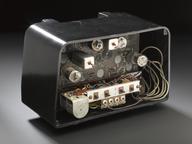

Valve broadcast receiver manufactured by Burne-Jones & Co, c.1931
- Made:
- circa 1931 in London

Valve broadcast receiver manufactured by Burne-Jones and Company, London, England for the British Wireless for the Blind, with braille markings, introduced 1931.
The British Wireless for the Blind Fund was set up in 1928 by Captain Sir Beechcroft Towse, a member of the armed forces who had lost his sight in 1900 during the Boer War, and who established the fund to help blind people with the often prohibitive cost of purchasing a radio. The BWBF was the only charity permitted to broadcast on Christmas Day, beginning in 1929 with an appeal by Winston Churchill. By 1931, the BWBF had raised £37,000 and provided 17,000 wireless sets to blind listeners.
In January 1931, the British Wireless for the Blind Fund placed an order for 5,000 single-valve receivers, of which this is one example. These single-valve sets were specially designed for use by the blind with braille markings on the dial, allowing a blind or partially sighted person to easily tune the radio.
Louis Braille developed his own system aged 15 years old, having lost his sight at a young age. Braille is a system in which raised dots in a six-dot cell represent each letter of the alphabet as well as equivalents for punctuation marks and symbols to show letter groupings, Braille is read by moving your hands from left to right along each line. Despite its contemporary popularity, Braille did not become universal in Louis’ lifetime— he died in 1852 and it was only adopted in France and England in the late 1800s (and later worldwide).
Details
- Category:
- Radio Communication
- Object Number:
- 1980-719
- Materials:
- wood (unidentified), metal (unknown) and electronic components
- Measurements:
-
overall: 190 mm x 440 mm x 180 mm, 2.63 kg
- type:
- radio receiver
- credit:
- Bussey, Gordon




